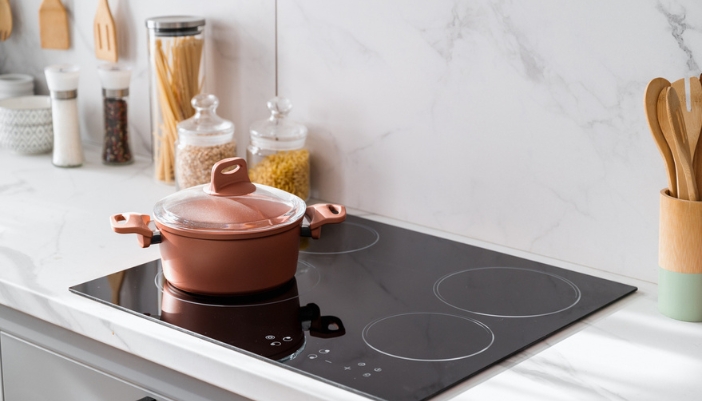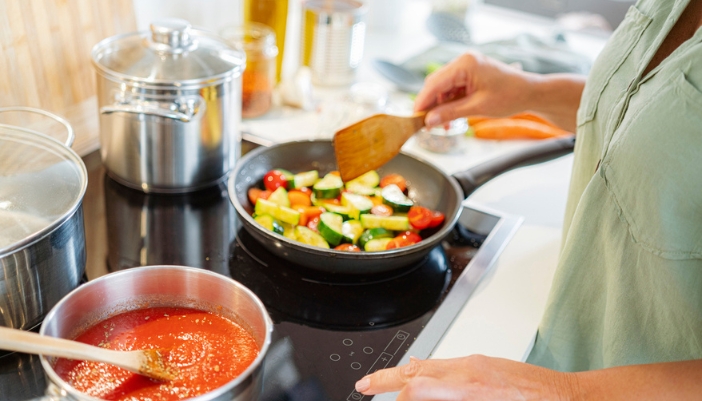You know that moment when you turn on your gas stove, and whoosh—a giant flame shoots up a little higher than you expected? Or when you're waiting (and waiting) for an electric burner to finally heat up? Cooking has come a long way, but traditional stovetops still have their quirks. That's why more and more home cooks are looking at induction cooktops as a serious upgrade!
But is it all it's cracked up to be? Our experts at D Boy Maytag Home Appliance Center have helped plenty of homeowners weigh the pros and cons, and the answer isn't one-size-fits-all. Let's take a closer look at what makes induction different and whether it's the right fit for your kitchen.

How Induction Cooking Works: The Power of Magnets
You turn on your stove, but nothing seems to happen instead of seeing a flame or a glowing red coil—until you place a pan on the surface, and suddenly, it's heating up in seconds. Welcome to the world of induction cooking, where science meets kitchen magic.
- Electromagnetic Energy at Work: Instead of direct heat, induction cooktops create a magnetic field that generates heat inside the cookware.
- No Open Flames or Hot Coils: The cooktop stays cool to the touch (except where the pan sits), reducing the risk of burns.
- Instant Heat Adjustment: Like gas, induction responds immediately when you turn the dial, but with even more precision.
- Only Works with Certain Cookware: Your pots and pans need a magnetic base to conduct the energy—if a magnet sticks to the bottom, you're good to go.
Pro Tip:
Not sure if your cookware is induction-compatible? Grab a fridge magnet and see if it sticks to the bottom. No stick? No heat!

Key Benefits of Induction Cooking
Cooking should be fast, efficient, and (ideally) mess-free—yet traditional stoves don't always cooperate. Gas can heat unevenly, electric can respond slowly, and both can turn a simple spill into a baked-on disaster. Induction cooktops, on the other hand, bring a fresh approach to kitchen convenience.
- Speed & Efficiency: Induction transfers heat directly to cookware, cutting down on preheat times and cooking food faster than gas or electric.
- Energy Savings: Less heat escapes into the kitchen, making induction one of the most efficient cooking methods.
- Precise Temperature Control: Instant heat adjustments allow perfect sears, simmering sauces, and everything in between.
- Safer Cooking: No open flames, no exposed coils, and a cooktop that stays cool to the touch means fewer kitchen hazards.
- Easy Cleanup: Spills won't burn onto the surface, so a simple wipe is often all it takes to keep your cooktop spotless.
Potential Drawbacks of Induction Cooktops
Induction cooking brings a lot to the table, but it's not a perfect fit for every kitchen. Like any appliance, it comes with its own set of trade-offs that might make you think twice before making the switch.
- Higher Upfront Cost: Induction cooktops tend to be more expensive than gas or electric models, though energy savings can help offset the cost over time.
- Cookware Compatibility: Not all pots and pans will work. If your cookware isn't magnetic, you may need to invest in new pieces.
- Learning Curve: Cooking on induction feels different, especially if you're used to gas. Some people take time to adjust.
- Power Dependency: Unlike gas stoves, induction won't work during a power outage, which could be a dealbreaker in some areas.

Who Should Switch? Is It Right for You?
Induction cooking isn't just for high-tech kitchens or professional chefs. It's a great fit for many home cooks—but not everyone. Whether or not it's the right choice depends on your cooking habits, kitchen setup, and priorities.
- Want Faster, More Efficient Cooking: If you're tired of waiting for burners to heat up, induction can speed things along using less energy.
- Value Precision and Control: Induction's instant adjustments are a game-changer if you love delicate sauces, perfectly seared steaks, or controlled simmering.
- Prioritize Safety: Families with young kids (or forgetful adults) may appreciate the cool-to-the-touch surface and automatic shutoff features.
- Prefer Easy Cleanup: If scrubbing burnt-on spills is your least favorite chore, induction's smooth glass surface makes cleaning much easier.
- Are Ready for a Modern Upgrade: If you're remodeling or looking for a sleek, minimalist look, induction can elevate your kitchen's design.
Ready to Make the Switch?
Induction cooking has its advantages, but it's not for everyone. If you love the idea of faster, safer, and more efficient cooking, it might be time to give it a try. On the other hand, if you're happy with your current setup, sticking with gas or electric is just fine, too.
Still on the fence? Our experts at D Boy Maytag Home Appliance Center are here to help! Whether you have questions about how induction works, need to test your cookware, or want to explore the best models, stop by and shop our selection. We'd love to help you find the perfect cooktop for your kitchen!